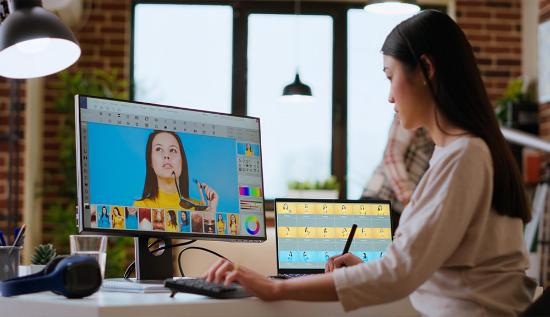VR/AR Designer Role Explained + Top Tools in 2025

Step into the future of design! Discover what a VR/AR Designer does, top tools in 2025, and how to launch your career in immersive tech.
In a world rapidly embracing spatial computing and immersive interfaces, the role of a VR/AR Designer has become more vital than ever. As industries expand their reach into virtual and augmented environments, the demand for creative minds who can bridge the digital and physical worlds has skyrocketed. In this article, we explore what a VR/AR designer does, the evolving AR/VR design jobs market, the unique responsibilities in augmented reality UX and AR/VR interface design, and highlight the best tools for AR/VR design in 2025.
What Does a VR/AR Designer Do?
A VR/AR designer is responsible for creating immersive digital environments and interactions that blend seamlessly with the real or virtual world. These professionals specialize in immersive experience design, which includes user interface (UI), user experience (UX), 3D modeling, animation, sound design, and spatial interaction.
In the context of virtual reality designer roles, the focus is on fully immersive environments — such as gaming, training simulations, or virtual real estate tours — where users are entirely absorbed in a virtual space via headsets like Meta Quest, HTC Vive, or Apple Vision Pro.
In contrast, augmented reality UX professionals design experiences that layer digital information over the real world. Think of AR apps that let users preview furniture in their homes or navigation apps that overlay directions on the streets in real time.
Key Responsibilities of a VR/AR Designer
Understanding what a VR/AR designer does requires diving into a variety of tasks, including:
- User Journey Mapping: Define how users move and interact within virtual or augmented environments.
- 3D Asset Creation: Use modeling tools to build virtual objects, avatars, or environmental assets.
- Interaction Design: Create intuitive gestures, haptic feedback, gaze-based navigation, and spatial audio.
- Prototyping and Testing: Use rapid prototyping tools to iterate on user flows and interface mechanics.
- Collaboration with Developers: Work closely with engineers to ensure design feasibility in Unity, Unreal Engine, or WebXR.
XR Designer Role in the Design Ecosystem
An XR designer (extended reality designer) typically spans both VR and AR disciplines, crafting experiences that move fluidly between real and digital spaces. This broader title reflects the convergence of technologies and is increasingly common in enterprise settings where one product might support both VR and AR modes.
The XR designer role goes beyond screens and devices. It involves reimagining the future of human-computer interaction—rethinking everything from office meetings to e-commerce in three-dimensional spaces.
AR/VR Design Jobs in 2025: The Landscape
The market for AR/VR design jobs has evolved dramatically. In 2025, AR/VR roles are no longer restricted to game studios. Industries hiring VR/AR designers now include:
- Healthcare: For medical training and AR-assisted surgeries.
- Retail & E-Commerce: Virtual try-ons and store experiences.
- Education: Immersive classroom simulations and AR tutoring.
- Automotive: Virtual prototyping and heads-up displays.
- Real Estate: 3D property walkthroughs and AR-enhanced blueprints.
Employers look for portfolios showcasing immersive experience design, user-centered thinking, and familiarity with modern design and development tools.
Best Tools for AR/VR Design in 2025
Choosing the right toolkit is essential for any virtual reality designer or augmented reality UX professional. Below are the best tools for AR/VR design in 2025, categorized by their strengths:
1. Unity & Unreal Engine
Both remain the backbone of real-time 3D development.
- Unity: Ideal for cross-platform AR/VR design.
- Unreal Engine 5: Offers high-fidelity visuals and increasingly streamlined workflows for designers.
2. Blender 4.0
This open-source 3D tool has become indispensable for creating detailed assets, animations, and VR-ready environments.
3. Adobe Aero & Substance 3D
Perfect for augmented reality UX prototyping and applying high-quality textures to models.
- Aero allows real-time AR experiences without coding.
- Substance 3D integrates seamlessly with Unity/Unreal.
4. Figma with 3D Plugins
Figma’s expanding plugin ecosystem now supports 3D mockups, making it a vital wireframing tool in AR/VR interface design pipelines.
5. Gravity Sketch & Tvori
Used widely for immersive experience design in VR, these tools support in-headset sketching, prototyping, and animation.
6. Lens Studio & Spark AR
These are still among the best tools for AR/VR design in 2025 when developing for social platforms like Snapchat and Instagram.
How to Become an AR/VR Designer in 2025
If you’re wondering how to become an AR/VR designer, here are the essential steps:
1. Learn the Foundations of UX/UI Design
Start with traditional UI/UX skills: wireframing, usability testing, and design systems. A strong base will transfer easily into spatial environments.
2. Master 3D and Spatial Thinking
Understand 3D modeling, animation principles, and depth-based interactions. Platforms like Blender and Sketchfab are perfect for practice.
3. Pick a Core Development Platform
Get comfortable with either Unity or Unreal. These engines are central to building real-time immersive experiences.
4. Experiment with Hardware
Work with devices like Meta Quest 3, Apple Vision Pro, or HoloLens to understand hardware constraints and interaction models.
5. Build a Strong Portfolio
Showcase personal projects, case studies, and end-to-end product flows. Include both AR/VR interface design and 3D experience walkthroughs.
6. Stay Updated on Industry Trends
Subscribe to communities like XR Bootcamp, AWE, and SIGGRAPH. Participate in hackathons and AR/VR design challenges.
Skills Every VR/AR Designer Needs
Whether you're focused on being an XR designer or a virtual reality designer, core skills include:
- Design Thinking – Applying problem-solving frameworks to immersive products.
- 3D Modeling & Animation – Creating usable, optimized assets for performance.
- Spatial UX – Understanding how users perceive and interact with 3D space.
- Motion Design – Designing intuitive transitions and animations in 3D space.
- Coding Basics – Knowing JavaScript, C#, or Blueprint can set you apart.
- AR/VR Interface Design – Creating responsive, accessible UIs that fit the medium.
Challenges Facing AR/VR Designers in 2025
While technology has advanced, several challenges remain for those in AR/VR design jobs:
- Device Fragmentation: From headsets to mobile AR glasses, each platform has unique specs and input models.
- User Onboarding: Designing intuitive onboarding in immersive environments requires new paradigms.
- Accessibility: Creating inclusive experiences that consider motion sickness, visibility, and disability is still evolving.
- Performance Optimization: Especially for AR, designs must be light and fast while remaining engaging.
Despite these challenges, demand for VR/AR designers continues to surge as more companies recognize the business value of immersive technologies.
Future of AR/VR Design Careers
The XR designer role is expected to evolve alongside AI, IoT, and 5G. Imagine designing for AI-driven AR glasses or digital twins that sync in real time across geographies. The boundaries between product design, engineering, and storytelling will blur further.
Companies like Meta, Apple, Google, Microsoft, and dozens of startups are actively recruiting AR/VR designers to pioneer the future of spatial computing. With the right skills and mindset, there’s never been a better time to enter this field.
Conclusion
The role of a VR/AR designer in 2025 is multifaceted, blending creativity, technical skills, and user empathy to shape how we interact with digital content. Whether you're exploring how to become an AR/VR designer or upgrading your workflow with the best tools for AR/VR design in 2025, the opportunities are vast and thrilling.
As the metaverse, mixed reality, and ambient computing continue to expand, AR/VR design jobs will become foundational to digital innovation across every industry.
More Articles
 03 Nov 2025
03 Nov 2025
Emotion AI: Understanding Human Emotions with Technology
Integrating Emotion AI with digital identity solutions brings intelligent authentication and emotionally aware digital interactions.
 31 Oct 2025
31 Oct 2025
Voice AI for Business Productivity: Efficiency & Automation
Boost workplace efficiency with Voice AI! Discover how natural language processing and voice assistants automate tasks and power business productivity.
 30 Oct 2025
30 Oct 2025
Urban Air Mobility | Air Taxi Services & Next-Gen Travel
Urban air mobility and air taxi services are redefining the future of urban transportation through sustainable eVTOL innovation and smart-city integration.
 30 Oct 2025
30 Oct 2025
Carbon Footprint Reduction with AI | Green AI Solutions
Carbon footprint reduction with AI is reshaping sustainability through smart energy use, emission control, and intelligent innovation.